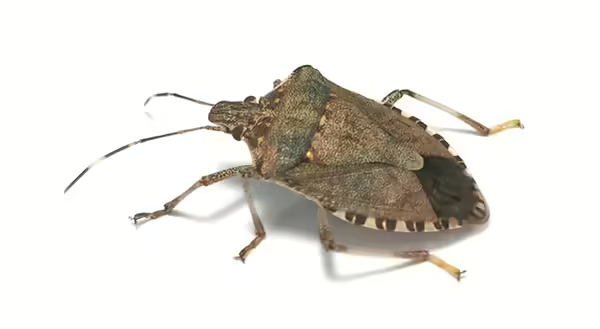
They are crawling on the windows, walls, and houseplants, newly rescued from the lower night temperatures of the fall. They could be hanging out on your dishes, doing a balancing act on your toothbrush, resting in your clothing or hair, or be a rather interesting ornament on your Christmas tree.
They are brown marmorated stink bugs, BMSB, and they are a new invader in Illinois homes as well as an invasive insect that may threaten our gardens. These insects are a nuisance because they do what stink bugs do best – stink, but only when threatened. The other issue is they move into your home without paying any rent.
This invasive insect was first identified in 1998 in Pennsylvania and causes most of the northeastern states to dread the autumn invasion. BMSB’s have a large host range feeding on the landscape, native and agriculturally important produce. The BMSB has piercing mouthparts and is capable of damaging a multitude of crops, from apples to pears to soybeans and landscape ornamentals. However, most reports so far come from urban areas during the fall, generally from homeowners and master gardeners detecting these invasive insects in their homes.
The BMSB body has the shield-shaped characteristic to stink bugs, and it is as wide as it is long. The three most identifying characteristics are its black and white banding on the antennae, the alternating dark/light banding on the edge of the wings, and the smooth shoulders.
They are capable of aggregating in manmade structures, and recent USDA studies show they prefer large dead trees that are still standing in the forest-like oak or hickory on the East Coast. After overwintering in April, the adult lays 20-30 eggs, with nymphs emerging shortly after. There can be multiple generations per year depending on seasonal temperatures.
Control stink bugs at home
- Use a vacuum to suck up adults or drop them in soapy water
- Take steps in early fall to caulk cracks and crevices around the house
- Prevent movement in from the outside by repairing windows and putting on door sweeps
- Perimeter spray of pyrethroids may be recommended
- It is not recommended to use sprays in the home because insecticide residues are relatively ineffective in providing control. The USDA currently classifies Illinois as being at low risk for the pest, as large numbers have not been recorded.
Learn more about Illinois invasive species.
Originally published by Kelly Allsup on May 24, 2021.
Photo source: Kristie Graham, USDA ARS, Bugwood.org